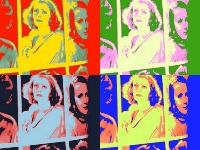| - by Walking Off The Big Apple -
"When we did pass, the brim of the hat flopped up and I saw her face. It was Greta Garbo wearing dark glasses, and totally oblivious to my presence. The face was still beautiful, but there was a sternness in it as she began walking a bit faster. She must have feared a word from me, some interference in her solitary morning exercise." - Wallace Fowlie, Sites: A Third Memoir (Duke University Press, 1987)
"I am not what you call a movie fan. When I worked, I had no time. I did not make time. I preferred to be out in the air doing something physical. When I stopped working, I preferred other activities, many other activities. I would rather be outside walking than to sit inside a theater and watch a picture moving. Walking is my greatest pleasure." - Greta Garbo, from an interview in Ingrid Bergman, A Personal Biography by Charlotte Chandler (Simon and Schuster, 2007)
A Pre-War Legend in Post-War New York

In October of 1953, two years after becoming a U.S. citizen, film legend Greta Garbo bought a spacious apartment in The Campanile at 450 E. 52nd St. A building of understated elegance by today's standards, the apartment building served the needs of discreet older New York families as well as other movie stars.
The building, which takes its architectural inspiration from the counterpart in Venice's Piazza San Marco, sits at the far quiet south end of the street and with views overlooking the East River. Garbo lived on the fifth floor with a view of the river and the Queensborough Bridge, and she decorated her seven rooms with attractive antiques and art.
From 1953 until her death on April 15, 1990, she spent much of her time walking the nearby streets. She typically took a walk in the morning and then another in the afternoon after lunch. Sometimes a friend would accompany her, and at other times she was content to stroll alone. Her biographers describe several of her favored routes. She liked to walk up 3rd Ave. to visit the antique shops, but she also frequented 1st and 2nd Avenues.
She often walked north on Madison Avenue to look at art galleries or over and down to the Waldorf Astoria to meet a friend for lunch. From her starting point at the east end of 52nd St. she would also walk to wherever the mood struck her. She would window shop or browse stores, and on a few occasions she bought something. Shopkeepers found her cordial.
In an attempt to capture the paths of this most famous fellow flâneuse, I followed in her footsteps over the past few days. Beginning at her apartment building at 450 E. 52nd St., I set out to see what Garbo might have seen, to envision as best I could the changing landscapes she may have encountered over a period of 35 years. I walked to a few of her known destinations, such as the Waldorf and the Museum of Modern Art, but I have no idea the specific route she chose. I am guessing that she was of the sort to improvise variations on the same path.
What struck me most was the idea that she was a pre-war movie star walking into post-war New York. From the vantage point of walking from east to west along 52nd Street, Garbo walked from the old world of a flickering cinematic memory into the brave new world of mid-century - the Seagram Building (1957) and the Lever House (1951-1952), the Colgate Palmolive Building (1955), and the Union Carbide Building (1960).
Greta Garbo, the most famous face on nitrate, chose to spend her notorious retirement at the dawn of a glassier, taller, quintessentially modern, and increasingly bureaucratic city that redefined New York. This was the fifties world of "the lonely crowd" and "the man in the gray flannel suit" and the dawn of television. For an independent and self-reliant woman in her late forties and in search of some solitude, she made the perfect choice.
Map of the area

Greta Garbo often walked up and down the streets you see before you, "Mademoiselle Hamlet," as Alice B. Toklas called her, wanting to be alone. Starting at her apartment on the East River, Garbo wandered west and mostly north through streets and avenues of Midtown and into the Upper East Side.
This area defines the very art of window-shopping, especially the upscale stores along Madison Avenue. While she lived well, Garbo was often frugal. On occasion she would treat herself to some favorite caviar at a food market, but most biographers agree that she just enjoyed browsing.
Of course, many stores that are here today were not around during Garbo's time. But, as she lived at 450 E. 52nd St. from 1953 until her death in 1990, she saw many new stores open and close, favorite restaurants shuttered or re-opened under new management, and new office buildings replace older landmarks. Even the older places underwent extensive remodeling.
This walk looks far in its entirety, but it's not hiking in the woods. If you want to rough it, you can buy good expensive trail mix at Eli Zabar's E.A.T., a little far north on Madison between 80th and 81st St. Also, this itinerary is much more deliberate and defined than the kind that Garbo would take.
I'll get into some of the details shortly, but feel free to click around on the interactive map and see what's here.
Garbo Walks: The Grand Hotels
![[waldorf.JPG]](Bilder/Garbo-Stories/Waldorf-a.jpg)
When the Palm Court of The Plaza Hotel reopens in December, I expect to re-enter the charmed space in full regalia – a little black Chanel dress, pearl necklace and earrings, white gloves, and my nicest pair of kicker boots. If the Palm Court does not live up to my memory of it as the very epicenter of New York elegance and style then I will be sorely disappointed.
Once upon a time, I dated a fun boy, eager to play Scott to my Zelda, who worked hard at spending his financial aid check for the entire semester on the two of us during the course of one glorious afternoon at the Palm Court. I have no memory of the details of my education that semester, such as the substance of Microbiology and You, but I remember how we drank scotch on the rocks and talked and how the violins played in the background and the moment when the maître d' came over, held our hands, and told us that we made him jealous because he wanted to be young again.
Greta Garbo would sometimes walk from her building at 450 E. 52nd St. to The Waldorf Astoria to meet a friend for lunch. She didn't have that far to go, as it's a quick stroll from her place to this grand hotel. With the main entrance located at 301 Park Avenue, the 2,000 room hotel sprawls in its Art Deco splendor over an entire city block. Guests staying in suites in the hotel's skyscraper towers access their rooms through discreet elevators.
As a fan of the grand hotel, I'm sad to see so many of the classic spaces refashioned for private purposes - The Mark and The Stanhope, among them. However, we still have The Waldorf Astoria, The St. Regis, The Carlyle, The Four Seasons, and The Pod.
The what? Yes. I wandered into the former site of the Pickwick Arms at 230 E. 51st and greeted the new groove thing, so play a little house music with me now while I give you the break down on this plugged-in pod. A hotel designed for your IPod and your laptop, and maybe you, The Pod features small cute rooms with all the needed hi-tech accessories and larger public spaces. I think they should take the concept of docking stations further, however, and furnish a device that you can plug directly into your body so that you can recharge it, too. Unlike the aforementioned palaces, The Pod may be affordable for the budget-minded traveler.
Remember WOTBA's motto of vacation planning is "Lodge Low, Drink High." If the Palm Court is not fabulous, but I am optimistic, I'm coming back and having a chat with management, bringing along my nanny, my turtle Skipperdee, and Weenie, the dog that looks like a cat.
Garbo Walks: Andy Warhol and the Crumpled Butterfly

Before Andy Warhol became the posthumously ubiquitous symbol of Fame itself, he consciously studied the fame of others. Settling into New York, the then window designer for the city's best stores modeled himself after the famously fabulous Truman Capote. Capote tired of Andy, so Andy got a hint to pursue other celebrities, including Garbo. Even in his own looks he started to fashion himself into a reclusive movie star type, selecting an appropriate wig and some dark glasses.
He got himself invited to a picnic with Greta Garbo. He was too shy to speak, so he drew a butterfly and handed it to her. "She looked at it bemused," recalled another guest. "At the end of the day, she absent-mindedly crumpled it and left it behind. Andy picked it up and had his mother write on it, ‘Crumpled butterfly by Greta Garbo'.”
From 1974 until his death, Warhol lived in a 30-room townhouse on East 66th Street. As Garbo walked through the neighborhood on her way to favorite stores and galleries along Madison, she probably strolled past his house many times. I can picture Warhol, by 1974 the most successful star-struck artist in the world and the one who understood the most about fame, peering down from a window and catching a glimpse of Garbo, the star who walked away from all that.
It's impossible to live in New York and be involved in the arts and not hear about Andy Warhol every single day. This year is the twentieth anniversary of his death, so Warhol-related events are happening in the city, and for that matter, all over the world.
Warhol died on February 22, 1987 at the age of 59. Garbo died three years later on April 15, 1990. She was 84.
|